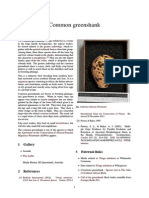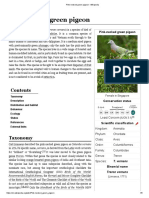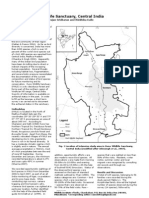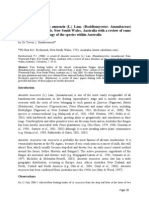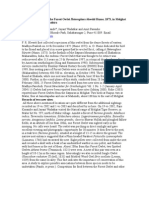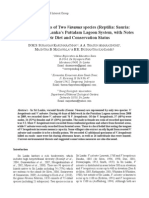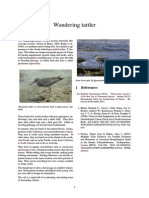Wood Sandpiper: 1 Description and Systematics
Wood Sandpiper: 1 Description and Systematics
Uploaded by
jansenCopyright:
Available Formats
Wood Sandpiper: 1 Description and Systematics
Wood Sandpiper: 1 Description and Systematics
Uploaded by
jansenOriginal Description:
Original Title
Copyright
Available Formats
Share this document
Did you find this document useful?
Is this content inappropriate?
Copyright:
Available Formats
Wood Sandpiper: 1 Description and Systematics
Wood Sandpiper: 1 Description and Systematics
Uploaded by
jansenCopyright:
Available Formats
Wood sandpiper
The wood sandpiper (Tringa glareola) is a small wader.
This Eurasian species is the smallest of the shanks,
which are mid-sized long-legged waders of the family
Scolopacidae.
Description and systematics
It resembles a longer-legged and more delicate green (T.
ochropus) or solitary sandpiper (T. solitaria) with a short
ne bill, brown back and longer yellowish legs. It diers
from the rst of those species in a smaller and less contrasting white rump patch, while the solitary sandpiper
has no white rump patch at all.[2]
However, it is not very closely related to these two species.
Rather, its closest relative is the common redshank (T.
totanus), and these two share a sister relationship with the
marsh sandpiper (T. stagnatilis). These three species are
a group of smallish shanks with red or yellowish legs, a
breeding plumage that is generally subdued light brown
above with some darker mottling and with a pattern of
somewhat diuse small brownish spots on the breast and
neck.[3]
Egg, Collection Museum Wiesbaden
Kwajalein in the Marshall Islands about once per decade.
This species is encountered in the western Pacic region
between mid-October and mid-May.[4] A slight westward
expansion saw the establishment of a small but permanent
breeding population in Scotland since the 1950s.
This bird is usually found on freshwater during migration
and wintering. They forage by probing in shallow water or
on wet mud, and mainly eat insects and similar small prey.
T. glareola nests on the ground or uses an abandoned old
tree nest of another bird, such as the eldfare (Turdus
pilaris).[2] Four pale green eggs are laid between March
and May.
Ecology
The wood sandpiper is one of the species to which the
Agreement on the Conservation of African-Eurasian Migratory Waterbirds (AEWA) applies.
Widespread, it is considered a Species of Least Concern
by the IUCN.[5]
3 Footnotes
[1] BirdLife International (2012). "Tringa glareola". IUCN
Version 2013.2.
Red List of Threatened Species.
International Union for Conservation of Nature. Retrieved 26 November 2013.
In non-breeding plumage
The wood sandpiper breeds in subarctic wetlands from
the Scottish Highlands across Europe and Asia. They
migrate to Africa, Southern Asia, particularly India, and
Australia. Vagrant birds have been seen as far into the
Pacic as the Hawaiian Islands. In Micronesia it is a regular visitor to the Mariana Islands (where ocks of up
to 32 birds are reported) and Palau; it is recorded on
[2] Hayman et al. (1986)
[3] Hayman et al. (1986), Pereira & Baker (2005)
[4] Hayman et al. (1986), Wiles et al. (2000), VanderWerf
(2006), VanderWerf et al. (2006)
[5] BLI (2008)
References
Hayman, Peter; Marchant, John & Prater, Tony
(1986): Shorebirds: an identication guide to the
waders of the world. Houghton Miin, Boston.
ISBN 0-395-60237-8
Pereira, Srgio Luiz & Baker, Alan J. (2005):
Multiple Gene Evidence for Parallel Evolution
and Retention of Ancestral Morphological States
in the Shanks (Charadriiformes: Scolopacidae).
The Condor 107(3): 514526. doi:10.1650/00105422(2005)107[0514:MGEFPE]2.0.CO;2 PDF fulltext
VanderWerf, Eric A. (2006): Observations on the
birds of Kwajalein Atoll, including six new species
records for the Marshall Islands. Micronesica 38(2):
221237. PDF fulltext
VanderWerf, Eric A.; Wiles, Gary J.; Marshall, Ann
P. & Knecht, Melia (2006): Observations of migrants and other birds in Palau, AprilMay 2005,
including the rst Micronesian record of a Richards
Pipit. Micronesica 39(1): 1129. PDF fulltext
Wiles, Gary J.; Worthington, David J.; Beck, Robert
E. Jr.; Pratt, H. Douglas; Aguon, Celestino F. &
Pyle, Robert L. (2000): Noteworthy Bird Records
for Micronesia, with a Summary of Raptor Sightings
in the Mariana Islands, 19881999. Micronesica
32(2): 257284. PDF fulltext
Pizzey, Graham and Knight, Frank: The Field Guide
to the Birds of Australia. HarperCollins, Sydney.
2012.
External links
Wood sandpiper Species text in The Atlas of
Southern African Birds.
Oriental Bird Images: Wood Sandpiper Selected
photos
Ageing and sexing (PDF; 1.8 MB) by Javier BlascoZumeta & Gerd-Michael Heinze
EXTERNAL LINKS
Text and image sources, contributors, and licenses
6.1
Text
Wood sandpiper Source: https://en.wikipedia.org/wiki/Wood_sandpiper?oldid=679739354 Contributors: William Avery, Jimfbleak,
JohnCastle, Robbot, Naddy, Radomil, Abigail-II, Xezbeth, Mwng, Takalinga, Hesperian, Caeruleancentaur, Kurt Shaped Box, Stemonitis,
Jannex, Pkuczynski, Koavf, Eubot, TeaDrinker, Gdrbot, The Rambling Man, YurikBot, Breakinguptheguy, Nicke L, Dysmorodrepanis~enwiki, Bota47, Lt-wiki-bot, Cato Neimoidia, Colonies Chris, Snowmanradio, Icelandic Hurricane, Paukrus, Bruinfan12, Drinibot,
Beastie Bot, Cydebot, Aviceda, Thijs!bot, Dnem, Lakmiseiru, JJ Harrison, Idioma-bot, TXiKiBoT, Rei-bot, David Condrey, Tsrawal,
SieBot, Fratrep, Martarius, Jmgarg1, Jotterbot, Addbot, Metsavend, SpBot, First Light, Luckas-bot, JackieBot, Materialscientist, ArthurBot, Simuliid, Gouerouz, U317537, TobeBot, Yunshui, EmausBot, Kmoksy, ZroBot, Tolly4bolly, ChuispastonBot, Rocketrod1960,
Cochoa, Faramir1138, ClueBot NG, Chrisdoyleorwell, Widr, Shantanu Kuveskar, Makecat-bot, HeinzelMann1, Goonerjonah, Bartkauz,
Coreyemotela, Klausrassinger and Anonymous: 19
6.2
Images
File:Commons-logo.svg Source: https://upload.wikimedia.org/wikipedia/en/4/4a/Commons-logo.svg License: ? Contributors: ? Original
artist: ?
File:Tringa_glareola_-_Laem_Phak_Bia.jpg Source:
https://upload.wikimedia.org/wikipedia/commons/d/d4/Tringa_glareola_-_
Laem_Phak_Bia.jpg License: CC BY-SA 3.0 Contributors: Own work Original artist: JJ Harrison (jjharrison89@facebook.com)
File:Tringa_glareola_MWNH_208.JPG Source: https://upload.wikimedia.org/wikipedia/commons/1/10/Tringa_glareola_MWNH_
208.JPG License: CC BY-SA 3.0 Contributors: Own work Original artist: Klaus Rassinger und Gerhard Cammerer, Museum Wiesbaden
File:Wood_Sandpiper_Photograph_By_Shantanu_Kuveskar.jpg Source: https://upload.wikimedia.org/wikipedia/commons/a/ae/
Wood_Sandpiper_Photograph_By_Shantanu_Kuveskar.jpg License: CC BY-SA 3.0 Contributors: Own work Original artist: Shantanu
Kuveskar
6.3
Content license
Creative Commons Attribution-Share Alike 3.0
You might also like
- IELTS Simon Reading Multiple Choice Worksheet Part6Document3 pagesIELTS Simon Reading Multiple Choice Worksheet Part6Achraf Gouad100% (1)
- Grey Tailed TattlerDocument3 pagesGrey Tailed TattlerjansenNo ratings yet
- Green Sandpiper: 1 Description 2 Distribution and EcologyDocument3 pagesGreen Sandpiper: 1 Description 2 Distribution and EcologyjansenNo ratings yet
- Common Greenshank: 1 Gallery 3 External LinksDocument3 pagesCommon Greenshank: 1 Gallery 3 External LinksjansenNo ratings yet
- Kahl Et Al., 2012 PDFDocument23 pagesKahl Et Al., 2012 PDFNo NameNo ratings yet
- Spotted Redshank: 1 TaxonomyDocument3 pagesSpotted Redshank: 1 TaxonomyjansenNo ratings yet
- Andean Bear Natural History and ConservaDocument36 pagesAndean Bear Natural History and ConservaValeria RuizNo ratings yet
- Marsh Sandpiper: 2 External LinksDocument2 pagesMarsh Sandpiper: 2 External LinksjansenNo ratings yet
- Solitary Sandpiper: 1 DescriptionDocument3 pagesSolitary Sandpiper: 1 DescriptionjansenNo ratings yet
- Trimeresurus Puniceus: TaxonomyDocument3 pagesTrimeresurus Puniceus: TaxonomyBoo Biing JyeNo ratings yet
- Pink-Necked Green Pigeon - WikipediaDocument5 pagesPink-Necked Green Pigeon - WikipediaJt WuNo ratings yet
- Giant GrouperDocument4 pagesGiant GrouperСергей ГнидинNo ratings yet
- New Records and Range Extensions of Birds From Timor, Alor and RoteDocument18 pagesNew Records and Range Extensions of Birds From Timor, Alor and RoteAl WiNo ratings yet
- Common Redshank: 2 SubspeciesDocument3 pagesCommon Redshank: 2 SubspeciesjansenNo ratings yet
- Marine Turtle Status and Conservation in The Indian Ocean (Kartik Shanker)Document1 pageMarine Turtle Status and Conservation in The Indian Ocean (Kartik Shanker)kethan2212No ratings yet
- A Synopsis of The Pin-Hole Borers of Thailand (Coleoptera: Curculionidae: Platypodinae)Document40 pagesA Synopsis of The Pin-Hole Borers of Thailand (Coleoptera: Curculionidae: Platypodinae)flechtma1466No ratings yet
- Reptile Rap #05 (Feb 2003)Document12 pagesReptile Rap #05 (Feb 2003)ReticulatusNo ratings yet
- ScalyDocument3 pagesScalySharmistha Talukder KhastagirNo ratings yet
- 2013 Yarnell Et Al A Novel Record of Aardwolf Proteles Cristata Feeding BehaviourDocument3 pages2013 Yarnell Et Al A Novel Record of Aardwolf Proteles Cristata Feeding BehaviouriVINo ratings yet
- Aust OdonataDocument290 pagesAust Odonataanien_dyahNo ratings yet
- 9 Dubos HerpetologyNotes Volume7 Pages21-23Document4 pages9 Dubos HerpetologyNotes Volume7 Pages21-23RaphaliNo ratings yet
- Helicops - Angulatus - Water MapepireDocument4 pagesHelicops - Angulatus - Water MapepireChantal AranNo ratings yet
- Species Diversity, Relative Abundance and Habitat Use of The Birds in The Sundarbans East Wildlife Sanctuary, BangladeshDocument8 pagesSpecies Diversity, Relative Abundance and Habitat Use of The Birds in The Sundarbans East Wildlife Sanctuary, BangladeshMd Abdullah Abraham HossainNo ratings yet
- Kuno Birds by T. RameshDocument5 pagesKuno Birds by T. RameshTharmalingam RameshNo ratings yet
- Global Diversity of Stoneflies Plecoptera InsectaDocument13 pagesGlobal Diversity of Stoneflies Plecoptera InsectaAsh MaedaevaNo ratings yet
- Pygmy Long Eared BatDocument2 pagesPygmy Long Eared BatH PNo ratings yet
- Hairy-Nosed Otter Conservation BrochureDocument5 pagesHairy-Nosed Otter Conservation BrochureAngela Leong Feng PingNo ratings yet
- Biodiversity of The National Zoo (Sri Lanka)Document9 pagesBiodiversity of The National Zoo (Sri Lanka)D.M.S. Suranjan KarunarathnaNo ratings yet
- Review Butterflies... Parandhaman Durairaj Et Al1Document18 pagesReview Butterflies... Parandhaman Durairaj Et Al1kaedehara.kazuha.belleNo ratings yet
- Currylowetal 2015bDocument4 pagesCurrylowetal 2015bvenicaveniceNo ratings yet
- Saguinus Geoffroyi,: Assessment By: Marsh, L.K., Cuarón, A.D. & de Grammont, P.CDocument13 pagesSaguinus Geoffroyi,: Assessment By: Marsh, L.K., Cuarón, A.D. & de Grammont, P.CJaime MoralesNo ratings yet
- MT Donna Buang Wingless Stonefly Riekoperla DarlingtoniDocument6 pagesMT Donna Buang Wingless Stonefly Riekoperla Darlingtoniapi-265809724No ratings yet
- Araucaria Hunsteinii - WikipediaDocument11 pagesAraucaria Hunsteinii - WikipediaСергей ГнидинNo ratings yet
- Primates in PerilDocument6 pagesPrimates in Perilapi-404882901No ratings yet
- Biogeographic Origins of VaranidsDocument19 pagesBiogeographic Origins of VaranidsThilani RupatungeNo ratings yet
- Tree Squirrels: Damage Prevention and Control MethodsDocument6 pagesTree Squirrels: Damage Prevention and Control MethodsJames GoldsteinNo ratings yet
- Butterflies of Anaikatti HillsDocument4 pagesButterflies of Anaikatti Hillsrameshkanu1No ratings yet
- Collar BlackBrowedBarbetDocument4 pagesCollar BlackBrowedBarbetEstephen FortelaNo ratings yet
- Nesting Records of Eastern Grass Owl Tyto (Capensis) Longimembris in Chiang Rai, Northern ThailandDocument3 pagesNesting Records of Eastern Grass Owl Tyto (Capensis) Longimembris in Chiang Rai, Northern ThailandAkalak KunsornNo ratings yet
- PASSIFLORACEAEDocument7 pagesPASSIFLORACEAEEmilio Lecaros BustamanteNo ratings yet
- Trevor J. Hawkeswood- A record of Amanita muscaria (L.) Lam. (Basidiomycetes: Amanitaceae) from Wentworth Falls, New South Wales, Australia with a review of some literature on the ecology of the species within AustraliaDocument3 pagesTrevor J. Hawkeswood- A record of Amanita muscaria (L.) Lam. (Basidiomycetes: Amanitaceae) from Wentworth Falls, New South Wales, Australia with a review of some literature on the ecology of the species within AustraliaGummyColaNo ratings yet
- Brightsmith Parrot Nesting in SE Peru Seasonality and Keystone Trees 2005Document10 pagesBrightsmith Parrot Nesting in SE Peru Seasonality and Keystone Trees 2005Jeff CremerNo ratings yet
- Tamandua - Tetradactyla - Southern Tamandua or Lesser AnteaterDocument6 pagesTamandua - Tetradactyla - Southern Tamandua or Lesser Anteaterjohnpiedra3055No ratings yet
- Bio Conservation EssayDocument10 pagesBio Conservation EssayMatt StraussNo ratings yet
- Forest OwletDocument3 pagesForest Owletapi-3814676No ratings yet
- TeratologyDocument12 pagesTeratologyWarisha RanaNo ratings yet
- 10.2305 IUCN - UK.2022-1.RLTS.T12551A199563077.enDocument24 pages10.2305 IUCN - UK.2022-1.RLTS.T12551A199563077.enMutiara IlmaNo ratings yet
- Populus Euphratica - WikipediaDocument12 pagesPopulus Euphratica - WikipediaСергей ГнидинNo ratings yet
- Reptiles Diversity of Kukulugala Forest (Sri Lanka)Document10 pagesReptiles Diversity of Kukulugala Forest (Sri Lanka)D.M.S. Suranjan KarunarathnaNo ratings yet
- Dasyurus Hallucatus,: Assessment By: Oakwood, M., Woinarski, J. & Burnett, SDocument10 pagesDasyurus Hallucatus,: Assessment By: Oakwood, M., Woinarski, J. & Burnett, SJovey SokhalNo ratings yet
- Amyda Cartilaginea (Boddaert 1770) - Asiatic Softshell Turtle, Southeast Asian Softshell TurtleDocument18 pagesAmyda Cartilaginea (Boddaert 1770) - Asiatic Softshell Turtle, Southeast Asian Softshell TurtleMartijn JohanNo ratings yet
- The Ants of Northern Australia: A Guide to the Monsoonal FaunaFrom EverandThe Ants of Northern Australia: A Guide to the Monsoonal FaunaRating: 3 out of 5 stars3/5 (1)
- Sundal and Book ChapterDocument7 pagesSundal and Book ChapterUCOK SINAGANo ratings yet
- Great Tit: Jump To Navigationjump To SearchDocument8 pagesGreat Tit: Jump To Navigationjump To SearchQuin CusayNo ratings yet
- Population Status of Varanus Species in Puttalam Lagoon (Sri Lanka)Document12 pagesPopulation Status of Varanus Species in Puttalam Lagoon (Sri Lanka)D.M.S. Suranjan KarunarathnaNo ratings yet
- HTTPSWWW - Nparks.gov - SG Mediasbgflora of Singaporevolume 13 Gentianales13, D, 1 Rubiaceae Lr1.AshxDocument358 pagesHTTPSWWW - Nparks.gov - SG Mediasbgflora of Singaporevolume 13 Gentianales13, D, 1 Rubiaceae Lr1.Ashxชนชนม์ ชูเชื้อNo ratings yet
- Ecology, Conservation and Management of Aspen - Scottish Aspen - Review 2010-74938Document42 pagesEcology, Conservation and Management of Aspen - Scottish Aspen - Review 2010-74938Chromaticghost2No ratings yet
- Meandrina - Meandrites - Maze CoralDocument5 pagesMeandrina - Meandrites - Maze CoralDavid Higuita RamirezNo ratings yet
- 1 s2.0 S0254629915301447 MainDocument23 pages1 s2.0 S0254629915301447 MainMirly BaptistaNo ratings yet
- Pteridium Aquilinum 2Document50 pagesPteridium Aquilinum 2Yessenia Gabriela Brito PonceNo ratings yet
- Willet: 2 FootnotesDocument2 pagesWillet: 2 FootnotesjansenNo ratings yet
- Wandering Tattler: 1 ReferencesDocument2 pagesWandering Tattler: 1 ReferencesjansenNo ratings yet
- Solitary Sandpiper: 1 DescriptionDocument3 pagesSolitary Sandpiper: 1 DescriptionjansenNo ratings yet
- Marsh Sandpiper: 2 External LinksDocument2 pagesMarsh Sandpiper: 2 External LinksjansenNo ratings yet
- Common Redshank: 2 SubspeciesDocument3 pagesCommon Redshank: 2 SubspeciesjansenNo ratings yet
- Mighty LambDocument1 pageMighty LambJessa Marie MaquilingNo ratings yet
- Borjas, 1987Document24 pagesBorjas, 1987isisbernalNo ratings yet
- Alpa Shah - Love of LabourDocument28 pagesAlpa Shah - Love of Labouranshulpatel0608No ratings yet
- 480 1876 1 PBDocument25 pages480 1876 1 PBBianca AdleNo ratings yet
- LSP Project TimelineDocument1 pageLSP Project Timelineapi-440175956No ratings yet
- OK074PBT PracticeTestDocument81 pagesOK074PBT PracticeTestss918No ratings yet
- Essentials of Migration Management For Policy Makers and PractitionersDocument21 pagesEssentials of Migration Management For Policy Makers and PractitionersRandy Alejaga RosalesNo ratings yet
- Nonfiction Reading Test Wintertime PDFDocument3 pagesNonfiction Reading Test Wintertime PDFSmulskii Andrii100% (1)
- Eleazer Ripley and Nathaniel Ripley, Residents in Bennington Vermont, by Emma Ripley Cornog C. 1938Document3 pagesEleazer Ripley and Nathaniel Ripley, Residents in Bennington Vermont, by Emma Ripley Cornog C. 1938Mark DionneNo ratings yet
- Effects of Imigration in BrazilDocument48 pagesEffects of Imigration in Brazilreinaldo nigroNo ratings yet
- Chapter 2, Section 4 Quiz. PP, and Study GuideDocument15 pagesChapter 2, Section 4 Quiz. PP, and Study Guidexxeileen09No ratings yet
- Waltham HistoryDocument3 pagesWaltham HistoryJack McPaddenNo ratings yet
- Country Presentation - IndonesiaDocument21 pagesCountry Presentation - IndonesiaADBI EventsNo ratings yet
- SQL Server Data Migration ApproachesDocument0 pagesSQL Server Data Migration ApproachesNeil CruzNo ratings yet
- Peter Sides - Ancient Historical Battles Volume 2 (Gosling Press) (OCR)Document45 pagesPeter Sides - Ancient Historical Battles Volume 2 (Gosling Press) (OCR)Harold_Godwinson90% (10)
- F1 VisaDocument3 pagesF1 VisacrgpatelNo ratings yet
- Migration Experiences - Interview TranscriptDocument4 pagesMigration Experiences - Interview TranscriptJamesNo ratings yet
- The Impacts of Forced Migration: (Lori and Boyle, 2015)Document4 pagesThe Impacts of Forced Migration: (Lori and Boyle, 2015)Anonymous 6pwLlVhNo ratings yet
- A Little History of ViequesDocument4 pagesA Little History of ViequesIdalieMNo ratings yet
- intermediate filaments PDFDocument26 pagesintermediate filaments PDFtamilavatar06No ratings yet
- Send RequestDocument10 pagesSend Requesthuangjunfeng1987No ratings yet
- Formato de NotasDocument23 pagesFormato de NotasAnonymous WuN8WJ8rNo ratings yet
- ACS Agent Authorisation FormDocument1 pageACS Agent Authorisation FormMr. RfNo ratings yet
- Yilmana DensaDocument23 pagesYilmana DensaJames Wiggins100% (1)
- Global Migration: Contemporary WorldDocument9 pagesGlobal Migration: Contemporary WorldshaylieeeNo ratings yet
- Malaysian MarketDocument5 pagesMalaysian MarketMarendra Putra Kundt100% (1)
- Primates PictorialDocument1 pagePrimates PictorialsasupraNo ratings yet
- Canada Immigration Forms: 5413EDocument18 pagesCanada Immigration Forms: 5413EOleksiy Kovyrin100% (1)
- Bird Migration 2Document15 pagesBird Migration 2AmiiiiNo ratings yet



